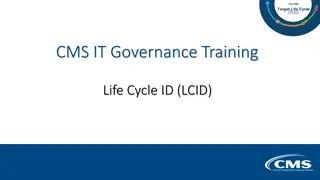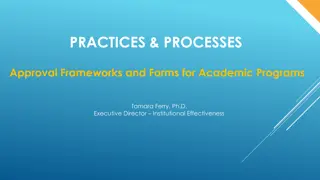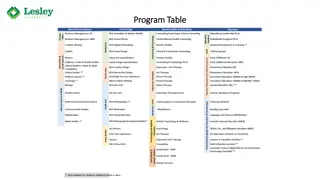Academic Approval Tracking System
Academic Approval Tracking System helps in creating, modifying, and terminating majors by following a structured process involving various key stakeholders and approval steps. It ensures efficient management of academic policies and curriculum changes at the university level.
Download Presentation

Please find below an Image/Link to download the presentation.
The content on the website is provided AS IS for your information and personal use only. It may not be sold, licensed, or shared on other websites without obtaining consent from the author.If you encounter any issues during the download, it is possible that the publisher has removed the file from their server.
You are allowed to download the files provided on this website for personal or commercial use, subject to the condition that they are used lawfully. All files are the property of their respective owners.
The content on the website is provided AS IS for your information and personal use only. It may not be sold, licensed, or shared on other websites without obtaining consent from the author.
E N D
Presentation Transcript
Academic Approval Tracking System Casey T. Griffith Assistant Director of Curriculum and Academic Policy Office of Undergraduate Affairs
N e w M a j o r R e q u e s t s Where to Start: Using the Approval System to create a New Major https://approval.ufl.edu/start-new-request/
M o d i f y M a j o r R e q u e s t s Where to Start: Using the Approval System to Modify a Major https://approval.ufl.edu/start-new-request/
N e w M a j o r R e q u e s t s Creating a New Major A new major may be created under an existing degree program. That is, UF must already be approved to offer a degree in that CIP code at that degree level. The new major must be reasonably associated with the degree program and it must share common core courses with any other majors in the same degree program. (Dr. Cathy Lebo, Assistant Provost and Director of Institutional Planning and Research) All new majors require an Academic Assessment Plan (AAP) to be submitted for approval during the first semester students are enrolled in the major. More information on AAPs is at the Institutional Assessment site. (Dr. Tim Brophy, Director of Institutional Assessment) *Currently each Professional Degree program has only one major. However, there is nothing prohibiting the establishment of an additional major within a degree program.
N e w M a j o r R e q u e s t s New Major Process: Department (Approval is required from the Chair or other designated approver for the department that will offer the academic program, typically following review by the department curriculum committee.) College (Approval is required from the Dean or other designated approver for the college or unit in the preceding step, typically following review by the college curriculum committee.) APUG (Approval is required by the Associate Provost for Undergraduate Affairs.) UCC (Approval is required from the University Curriculum Committee.) FSSC (Approval is required from the Faculty Senate Steering Committee.) Senate (Approval is required from the Faculty Senate.) AA (Approval is required from Academic Affairs.) BOT [N] (The Board of Trustees is notified of the request.) AA [N] (Academic Affairs is notified of the request.) 10. OUR (Approval is required from the Office of the University Registrar.) 11. OIPR [N] (The Office of Institutional Planning and Research is notified of the request.) 12. SASS (The change will be entered into the Student Academic Support System, effective in the term approved for the request.) 13. CAT (The change will be entered into the undergraduate catalog, effective in the term approved for the request.) 14. AAC [N] (The Academic Assessment Committee is notified of request approval.) 15. College [N] (The College is notified of request approval. 1. 2. 3. 4. 5. 6. 7. 8. 9. *Highlighted steps can add on multiple months per step. *Termination of a Major mirrors this process with additional notification to SACS Director
M o d i f i c a t i o n R e q u e s t s Example: Changing the Name of a Major 1.Department (Approval is required from the Chair or other designated approver for the department that will offer the academic program, typically following review by the department curriculum committee.) 2.College (Approval is required from the Dean or other designated approver for the college or unit in the preceding step, typically following review by the college curriculum committee.) 3.APUG (Approval is required by the Associate Provost for Undergraduate Affairs.) 4.UCC (Approval is required from the University Curriculum Committee.) 5.FSSC (Approval is required from the Faculty Senate Steering Committee.) 6.Senate(Approval is required from the Faculty Senate.) 7.AA (Approval is required from Academic Affairs.) 8.BOT [N] (The Board of Trustees is notified of the request.) 9.OUR (Approval is required from the Office of the University Registrar.) 10.OIPR [N] (The Office of Institutional Planning and Research is notified of the request.) 11.SASS (The change will be entered into the Student Academic Support System, effective in the term approved for the request.) 12.CAT (The change will be entered into the undergraduate catalog, effective in the term approved for the request.) 13.College [N] (The College is notified of request approval.) *Highlighted steps can add on multiple months per step.
M o d i f y C o n c e n t r a t i o n R e q u e s t s Creating/Modifying a Concentration A concentration is an organized curriculum within a graduate or professional major that enhances or complements the major in a manner which leads to specific educational or occupational goals. This process should be used to create a new concentration in an existing professional major. 1.Department (Approval is required from the Chair or other designated approver for the department that will offer the academic program, typically following review by the department curriculum committee.) 2.College (Approval is required from the Dean or other designated approver for the college or unit in the preceding step, typically following review by the college curriculum committee.) 3.UCC (Approval is required from the University Curriculum Committee.) 4.OUR (Approval is required from the Office of the University Registrar.) 5.SASS (This step is retained as part of the parallel undergraduate process.) 6.CAT (This step is retained as part of the parallel undergraduate process.) 7.College [N] (The College is notified of request approval.)
D o c u m e n t a t i o n R e q u e s t s New/Modify Documentation Required Documents: Catalog copy - catalog-style description of the concentration requirements for entry, requirements for completion, and a suggested semester-by-semester plan, prepared in Microsoft Word. Supporting documentation - memos, emails, etc. from other units to provide evidence of the availability of courses that are required in the concentration and/or to provide evidence for support of the proposed concentration if there is clear or potential overlap or duplication of content. The reviewing committees will need reference documents to understand the changes. While there is not a professional catalog currently, the current best practice is to use a model curriculum with tracked changes enabled. Additional samples of plans or an academic year(s) may also be asked for by a committee.
N e w C o n c e n t r a t i o n R e q u e s t s Example of New Concentration Request: Doctor of Athletic Training Request link: https://secure.aa.ufl.edu/Approval/reports/14411 Submitted to Approval System: November 2019 Approved by UCC: December 2019 Concentration Created by Registrar: December 2019 Final Approval Notifications: May 2020
T e a c h O u t P l a n s Modification of Major/Concentrations: Effects on Students There is no University requirement for students to move into a new curriculum if it is changed while they are current students. Accreditation may require students to move into a new curriculum. A college may require students to move into a new curriculum. There must be a teach-out plan for curriculum changes: If students are required to move to a new curriculum, how will this be managed? If students are not required to move to new curriculum, what will the plan be for offering the content/courses for both curriculums? Should include timeline for graduation for students in either option. Requests for termination of a major or concentration should include teach-out plans for any remaining students






